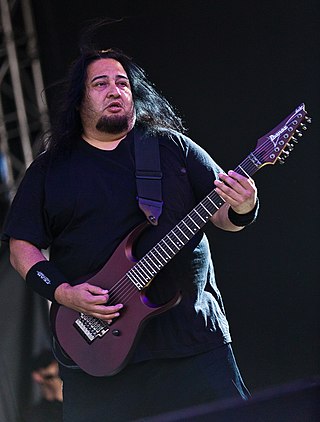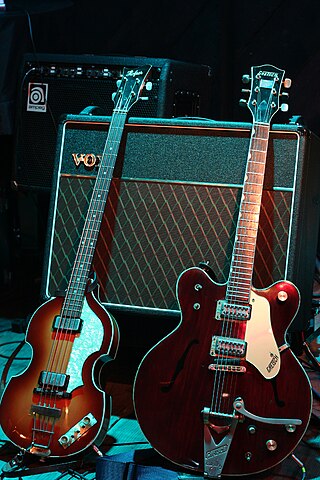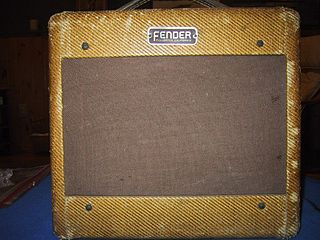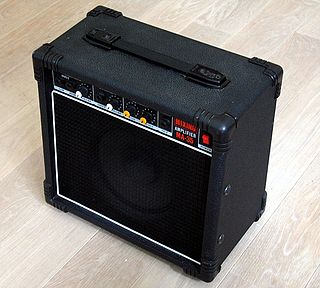
An effects unit, effects processor, or effects pedal is an electronic device that alters the sound of a musical instrument or other audio source through audio signal processing.

Vox is a British musical equipment manufacturer founded in 1957 by Thomas Walter Jennings in Dartford, Kent, England. The company is most famous for making the Vox AC30 guitar amplifier, used by The Beatles, The Rolling Stones, The Kinks, The Yardbirds, Queen, Dire Straits, U2, and Radiohead; the Vox Continental electric organ, the Vox wah-wah pedal used by Jimi Hendrix, and a series of innovative electric guitars and bass guitars. Since 1992, Vox has been owned by the Japanese electronics firm Korg.

An instrument amplifier is an electronic amplifier that converts the often barely audible or purely electronic signal of a musical instrument into a larger electronic signal to feed to a loudspeaker. An instrument amplifier is used with musical instruments such as an electric guitar, an electric bass, electric organ, electric piano, synthesizers and drum machine to convert the signal from the pickup or other sound source into an electronic signal that has enough power, produced by a power amplifier, to drive one or more loudspeaker that can be heard by the performers and audience.

A guitar amplifier is an electronic device or system that strengthens the electrical signal from a pickup on an electric guitar, bass guitar, or acoustic guitar so that it can produce sound through one or more loudspeakers, which are typically housed in a wooden cabinet. A guitar amplifier may be a standalone wood or metal cabinet that contains only the power amplifier circuits, requiring the use of a separate speaker cabinet–or it may be a combo amplifier, which contains both the amplifier and one or more speakers in a wooden cabinet. There is a wide range of sizes and power ratings for guitar amplifiers, from small, lightweight practice amplifiers with a single 6-inch speaker and a 10-watt amp to heavy combo amps with four 10-inch or four 12-inch speakers and a 100-watt amplifier, which are loud enough to use in a nightclub or bar performance.

Peavey Electronics Corporation is a privately-owned American company which designs, develops, manufactures, and markets professional audio equipment. Headquartered in Meridian, Mississippi, Peavey is one of the largest audio equipment manufacturers in the world.

Marshall Amplification is a British company that designs and manufactures music amplifiers and speaker cabinets. Founded in London by shop owner and drummer Jim Marshall, the company is based in Bletchley, Milton Keynes, England. Since March 2023, Marshall Amplification has been one of several divisions of the Swedish conglomerate, the Marshall Group.

Mesa/Boogie is an American company in Petaluma, California, that manufactures amplifiers and other accessories for guitars and basses. It has been in operation since 1969.
Line 6 is a musical instrument and audio equipment manufacturer, best known as a pioneer in guitar amplifier and effect modeling. The company's products include guitar effects, modeling guitar amplifiers, software, electric guitars, and wireless systems. Line 6 has an active user community, and provides software that allows users to easily download and share patches or device settings for many of the company's products. Founded in 1996 and headquartered in Calabasas, California, the company has been a subsidiary of Yamaha Corporation since 2014.

Ampeg is a manufacturer best known for its bass amplifiers.

Dino Cazares is an American musician, best known as the guitarist and one of the co-founders of industrial metal band Fear Factory. He is also a co-founder of Divine Heresy, Asesino, and Brujeria. Cazares popularized the use of digital amp modelling processors, as well as the use of seven and eight-string guitars in metal music.

Peter Hayes is an American musician and singer, best known as a member of the rock band Black Rebel Motorcycle Club.

The Vox AC30 is a guitar amplifier manufactured by Vox. It was introduced in 1958 to meet the growing demand for louder amplifiers. Characterised by its "jangly" high-end sound it has become widely recognized by British musicians and others, such as George Harrison and John Lennon of the Beatles, Bill Wyman of the Rolling Stones, Brian May of Queen, Dave Davies of the Kinks and Hank Marvin.

A bass amplifier is a musical instrument electronic device that uses electrical power to make lower-pitched instruments such as the bass guitar or double bass loud enough to be heard by the performers and audience. Bass amps typically consist of a preamplifier, tone controls, a power amplifier and one or more loudspeakers ("drivers") in a cabinet.

The Fender Twin and Twin Reverb are guitar amplifiers made by Fender Musical Instruments Corporation. The Twin was introduced in 1952, two years before Fender began selling Stratocaster electric guitars. The amps are known for their characteristically clean tone.

The Fender Champ was a guitar amplifier made by Fender. It was introduced in 1948 and discontinued in 1982. An updated version was introduced in 2006 as part of the "Vintage Modified" line.
The Line 6 Flextone was the first in a series of guitar amplifiers to package Line 6's POD digital modeling system in a stand-alone amplifier product. Digital modeling allowed users to access guitar tones based on those of many popular vintage and boutique amplifiers. At the time of its release in the late 1990s, the Flextone series was a more affordable alternative to the company's flagship Vetta amplifier.

Guitar Rig is an amp and effects modeling software package developed by Native Instruments. The software can function either as a standalone application, or as a plug-in for other software. It was originally released in 2004.

Record is a music software program developed by Swedish software developers Propellerhead Software. Designed for recording, arrangement and mixing, it emulates a recording studio, with a mixing desk, a rack of virtual instruments and effects and an audio and MIDI sequencer. Record can be used either as a complete virtual recording studio in itself, or together with Propellerhead Software's Reason.
Amplifier modeling is the process of emulating a physical amplifier such as a guitar amplifier. Amplifier modeling often seeks to recreate the sound of one or more specific models of vacuum tube amplifiers and sometimes also solid state amplifiers.

A keyboard amplifier is a powered electronic amplifier and loudspeaker in a speaker cabinet used for the amplification of electronic keyboard instruments. Keyboard amplifiers are distinct from other types of amplification systems such as guitar amplifiers due to the particular challenges associated with making keyboards sound louder on stage; namely, to provide solid low-frequency sound reproduction for the deep basslines that keyboards can play and crisp high-frequency sound for the high-register notes. Another difference between keyboard amplifiers and guitar/bass amplifiers is that keyboard amps are usually designed with a relatively flat frequency response and low distortion. In contrast, many guitar and bass amp designers purposely make their amplifiers modify the frequency response, typically to "roll-off" very high frequencies, and most rock and blues guitar amps, and since the 1980s and 1990s, even many bass amps are designed to add distortion or overdrive to the instrument tone.

















